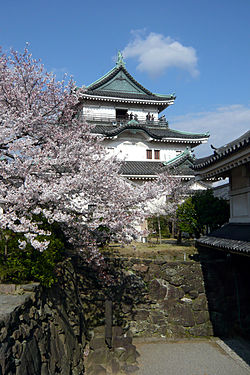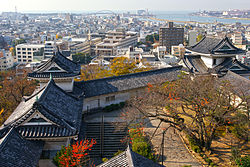Wakayama Castle
| Wakayama Castle 和歌山城 | |
|---|---|
| Wakayama, Wakayama Prefecture, Japan | |
 | |
| Type | Hirayamashiro (hilltop castle) |
| Height | Three stories |
| Site information | |
| Condition | The tenshu and some connected buildings were reconstructed using concrete in 1958. |
| Site history | |
| Built | 1585-1586 |
| Built by | Toyotomi Hidenaga |
| In use | 1586 to 1945 |
| Materials | Earth, stone, and wood |
| Demolished | Most of the castle during the Meiji Restoration, though the tenshu survived until its destruction from firebombing in 1945. |


Wakayama Castle (和歌山城, Wakayama-jō) in Wakayama, Wakayama Prefecture, Japan, sits at the mouth of the Kii River. Originally Ōta castle, home of the Saiga Ikki, it was captured by Toyotomi Hideyoshi in 1585, during the siege of Negoro-ji; many monks from Negoro-ji sought refuge in Ōta, which was soon destroyed by flood. Hideyoshi ordered the building of dams on three sides of the castle, focusing the rainwaters and diverting the river to ruin the castle. As hunger set in, the samurai, monks, and peasants inside Ōta surrendered, and fifty warrior monks led a final suicidal charge against Hideyoshi's army.
Ōta was rebuilt as a temple for the Shushin branch of Japanese Buddhism, to break from its history as a home to warrior monks. Wakayama Castle was then built on the same site, under the supervision of Toyotomi Hidenaga, Hideyoshi's brother, with Tōdō Takatora's participation. Asano Yoshinaga arrived in 1600 to serve as feudal lord, under Tokugawa Ieyasu.
In 1615 the castle was attacked by forces loyal to Toyotomi Hideyori, who were trying to end the siege of Osaka. In the summer of 1615, parts of the Osaka garrison left the city, ambushing various elements of the Tokugawa forces. Ono Harunaga, Hanawa Naoyuki and Okabe Noritsuna led part of the garrison in attacking Wakayama Castle, held by Asano Nagaakira at the time. They had with them 3000 men, but the castle had 5000 in its garrison. Asano's men left the castle to meet the Western (Toyotomi) forces in what came to be known as the 'battle of Kashii.' Hanawa and Okabe were killed, and Ono was forced to flee back to Osaka.
In 1791 the US captains John Kendrick of the Lady Washington and William Douglas of the Grace visited Kushimoto, hoping to open a trading relationship with Japan. News was sent to Wakayama Castle, which sent troops. However, Kendrick and Douglas departed two days before the troops arrived. The result of this first visit of Americans to Japan was largely symbolic for the United States. For Japan it resulted in a new system of alarms and coastal patrols, increasing Japan's isolation under sakoku.[1][2][3]
The castle's current appearance matches renovations made by Tokugawa Yorinobu, tenth son of Tokugawa Ieyasu, in the early 17th century.
At the end of the Edo period, in 1867, the feudal structure fell apart, and Wakayama Castle was opened to the public for the first time.
The castle was destroyed by Allied bombing during World War II, but was rebuilt in 1958 out of concrete and is open to the public as a symbol of the city and historical site.[4]
Literature[]
- Benesch, Oleg and Ran Zwigenberg (2019). Japan's Castles: Citadels of Modernity in War and Peace. Cambridge: Cambridge University Press. p. 374. ISBN 9781108481946.
- Schmorleitz, Morton S. (1974). Castles in Japan. Tokyo: Charles E. Tuttle Co. ISBN 0-8048-1102-4.
- Motoo, Hinago (1986). Japanese Castles. Tokyo: Kodansha. p. 200 pages. ISBN 0-87011-766-1.
References[]
- ^ Ridley, Scott (2010). Morning of Fire: John Kendrick's Daring American Odyssey in the Pacific. Harper Collins. p. 225. ISBN 978-0-06-202019-2.
- ^ Johnson, Donald Dalton; Best, Gary Dean (1995). The United States in the Pacific: Private Interests and Public Policies, 1784-1899. Greenwood Publishing Group. p. 23. ISBN 978-0-275-95055-2. Retrieved 22 July 2012.
- ^ White, Michael (2009). A short course in international marketing blunders [electronic resource]: mistakes made by companies that should have known better. World Trade Press. pp. 111–112. ISBN 978-1-60780-008-8. Retrieved 22 July 2012.
- ^ Wakayama Castle Profile Retrieved August 25, 2016
External links[]
![]() Media related to Wakayama Castle at Wikimedia Commons
Media related to Wakayama Castle at Wikimedia Commons
- English page at Wakayama City's official site
- Japanese page for some more information
- Sightseeing Guide at Wakayama City's official site
- Wakayama Castle - Japan Castle Guide
- 402167963 Wakayama Castle on OpenStreetMap
Coordinates: 34°13′39.46″N 135°10′17.84″E / 34.2276278°N 135.1716222°E
- Castles in Wakayama Prefecture
- Museums in Wakayama Prefecture
- History museums in Japan
- Important Cultural Properties of Japan
- Historic Sites of Japan
- Buildings and structures in Japan destroyed during World War II


